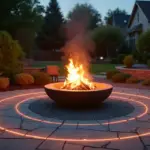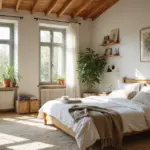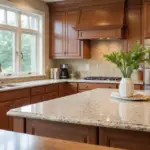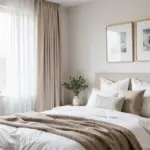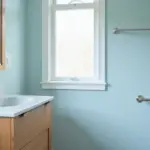White cabinets are like a blank canvas awaiting your artistic touch. They open up your kitchen, reflect light beautifully, and provide the perfect backdrop for the real star of the show: your countertops. As both an artist and space designer, I’ve discovered that the right countertop doesn’t just complete your kitchen—it transforms it into a functional studio where life and creativity merge.
Let’s explore 22 countertop options that pair beautifully with white cabinets, creating spaces that inspire both culinary and artistic pursuits. Each material brings its own character, from the pristine elegance of white quartz to the rustic charm of butcher block. Whether you’re designing a live-work space or simply want a kitchen that sparks creativity, these pairings will help you craft a space that’s both practical and visually stunning.
1. Classic White Quartz with White Cabinets: A Seamless Canvas
White quartz countertops paired with white cabinets create a seamless, bright aesthetic that makes any kitchen feel larger and more open. This pairing works because it amplifies light while maintaining visual interest through subtle variations in white tones. Like a well-primed canvas, this combination provides a perfect foundation for your kitchen’s composition.

The practical benefits are just as compelling as the aesthetic ones. Quartz resists stains and scratches beautifully, requires no sealing, and maintains its pristine appearance with minimal effort. For artists and creatives who use their kitchen as an extension of their studio space, this durability means freedom to create without constant worry about maintenance.
“The interplay between slightly different whites creates depth without distraction—perfect for spaces where both cooking and creative thinking need to flourish.”
As we move from the pure white palette, let’s explore how the delicate veining of Carrara marble can introduce subtle movement and classical beauty to your white kitchen canvas.
2. Carrara Marble: Natural Artistry for White Cabinet Kitchens
Carrara marble brings the subtle beauty of natural stone to white cabinet kitchens. Its soft gray veining against a white background creates gentle contrast that prevents the kitchen from feeling sterile while adding visual warmth. This material has adorned spaces from Renaissance sculptures to modern kitchens, bringing timeless elegance to any space it graces.
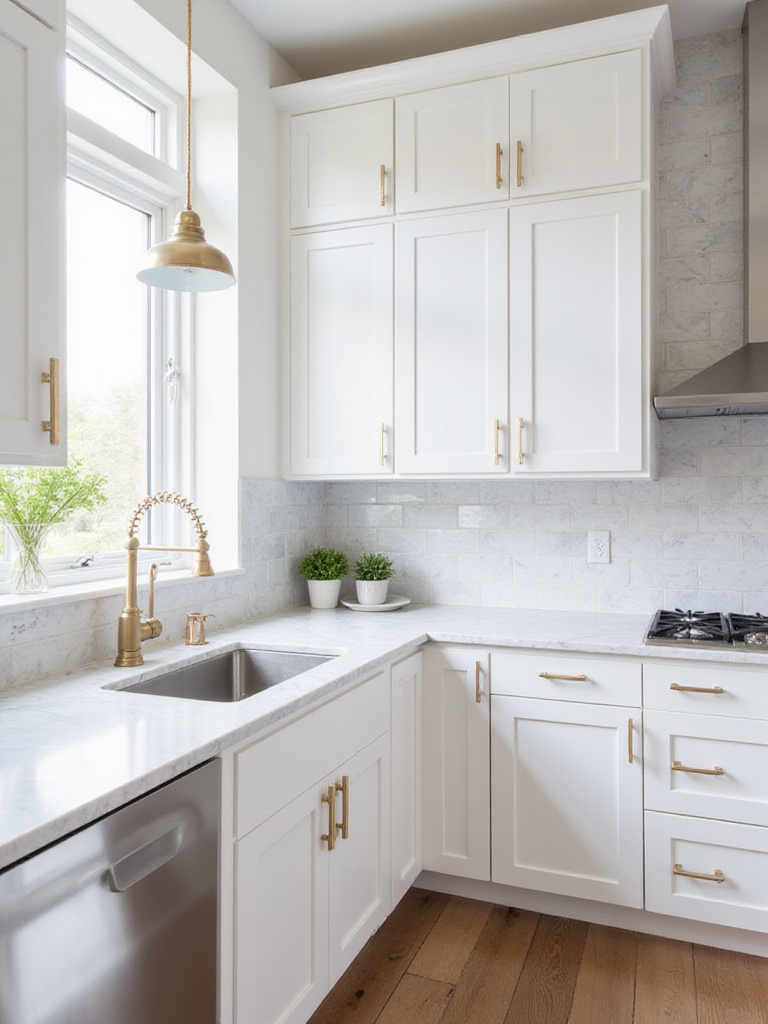
When considering Carrara marble for kitchen countertops with white cabinets, weigh its undeniable beauty against practical concerns. While it adds luxury and increases home value, it requires regular sealing and careful maintenance to prevent staining and etching. Many artists appreciate how marble develops a patina over time—a living record of your kitchen’s history, much like a well-used studio space.
The magic of Carrara lies in how it transitions a kitchen from merely functional to truly inspirational. Running your hand across its cool, smooth surface connects you to centuries of artistic tradition.
3. Gray Quartz: Practical Sophistication for White Cabinet Kitchens
Gray quartz countertops provide the perfect counterpoint to bright white cabinets, creating balance that prevents your kitchen from feeling too clinical. This pairing grounds the space while maintaining the light, airy quality that makes white cabinets so popular. The neutral gray acts as a visual anchor, allowing your white cabinetry to remain the bright, reflective element in your kitchen’s composition.

The low-maintenance nature of quartz countertops with white cabinets makes this combination particularly appealing for busy creative professionals. Unlike natural stone, quartz requires no sealing and resists stains and bacteria naturally. For those who use their kitchen as both cooking and creative space, this practicality means more time for your projects and less time worrying about maintenance.
- Choose warm grays with beige undertones for cream or off-white cabinets
- Opt for cooler grays with blue undertones for bright white cabinets
- Consider mid-tone grays for versatility with most white shades
Like a carefully chosen neutral in a painting, gray quartz sets the stage for bolder design elements while creating a sophisticated foundation. Now, let’s explore how dramatic black granite can create striking contrast against white cabinets for those seeking a more bold statement.
4. Black Granite: Bold Drama for White Kitchen Cabinets
Black granite countertops create magnificent drama against white cabinets, establishing a high-contrast pairing that feels both timeless and striking. The depth and richness of black granite—from the pure darkness of Absolute Black to the constellation-like sparkle of Black Galaxy—anchors the brightness of white cabinetry, creating visual tension that energizes the entire space.

The pattern and finish you select dramatically impact the final aesthetic. Highly polished black granite creates a sleek, reflective surface that amplifies light and adds glamour, while honed or leathered finishes provide a matte, textured look that feels warmer and more organic. This textural choice can completely transform how the kitchen countertops with white cabinets interact visually, making it crucial to consider how light plays in your specific space.
- Use a light-colored backsplash to soften the stark contrast
- Choose hardware that bridges black and white (brushed nickel or brass)
- Incorporate natural elements like wood cutting boards to add warmth
The striking interplay between black granite and white cabinets creates a bold foundation for any kitchen. Moving from this dramatic contrast, let’s explore how the warm tones of butcher block can introduce organic texture and natural warmth to white kitchens.
5. Butcher Block: Warm Wood Tones for White Cabinet Kitchens
Butcher block countertops bring undeniable warmth and natural beauty to kitchens with white cabinets. The rich, organic wood grain creates visual texture against the crisp lines of white cabinetry, softening the potential starkness and preventing the space from feeling sterile. As an artist who values tactile experiences, I find that wood countertops invite touch in a way that stone simply doesn’t—they warm to your hands as you work.

This combination strikes a perfect balance between clean aesthetics and rustic charm, making it adaptable to various design preferences from farmhouse to contemporary. The affordability of butcher block relative to stone countertops makes it an accessible way to introduce natural beauty into your kitchen, while its ability to be sanded and refinished extends its lifespan considerably.
When working with creative clients designing live-work spaces, I often recommend butcher block for areas where they’ll spend hours standing. The forgiving surface is gentler on the body than stone, making it ideal for those who view their kitchen as an extension of their studio.
6. Concrete Countertops: Industrial Edge for White Kitchen Cabinets
Concrete countertops offer a striking visual contrast against the clean backdrop of white cabinets, injecting industrial character and urban personality into your kitchen space. The raw, natural texture of concrete brings organic warmth and understated charm that prevents an all-white kitchen from feeling impersonal—much like how a textured canvas adds dimension to a painting before the first brushstroke.

The remarkable versatility of concrete in terms of color, texture, and shape opens endless customization possibilities. With proper sealing, concrete is durable and long-lasting, though it requires regular maintenance to prevent staining and cracking. For artists and makers who appreciate materiality and process, concrete’s transformation from liquid to solid form embodies the creative spirit of making something from basic elements.
- Consider integrating embedded objects like glass or shells for unique texture
- Explore different concrete tints for subtle color variations
- Experiment with different finishing techniques for varied surface textures
Concrete’s industrial charm creates spaces that feel both contemporary and timeless. As we shift from the urban edge of concrete, let’s explore the rustic elegance of soapstone countertops that bring farmhouse character to white kitchens.
7. Soapstone: Rustic Elegance for White Cabinet Kitchens
Soapstone countertops pair brilliantly with white cabinets, creating a farmhouse-inspired aesthetic that feels both timeless and inviting. The naturally matte finish and subtle veining of soapstone provide beautiful contrast to crisp white cabinetry, while its soft, tactile texture adds warmth that prevents the space from feeling too sterile. This combination grounds the brightness of white with the earthy, substantial presence of soapstone.

When selecting soapstone for kitchen countertops with white cabinets, consider the density and veining that best suits your design vision. “Architectural” or “Hard” soapstone offers greater durability with less dramatic veining, while “Artistic” or “Soft” soapstone showcases more prominent veining and character that aligns perfectly with farmhouse charm. Both types develop a beautiful patina over time, telling the story of your kitchen’s life much like an artist’s hands show the evidence of their craft.
The natural heat resistance of soapstone makes it ideal for serious cooks, allowing hot pots to be placed directly on the surface without damage—a practical consideration for creative spaces where function must match form.
8. Budget-Friendly Laminate: Affordable Elegance with White Cabinets
Modern laminate countertops offer a surprisingly sophisticated way to achieve high-end looks without the hefty price tag when paired with white cabinets. Today’s technology has revolutionized laminate production, creating remarkably realistic patterns that mimic marble, granite, and other premium materials at a fraction of the cost. For creative professionals designing on a budget, these advances make stylish kitchen countertops with white cabinets accessible without compromising visual impact.

The practical benefits of laminate extend beyond affordability. These surfaces resist staining and etching better than natural marble, require minimal maintenance, and offer greater design flexibility with a wider range of patterns. While laminate lacks the depth and character of natural stone and can be damaged by high heat, strategic styling can minimize these limitations and maximize its strengths.
- Choose laminates with subtle, realistic veining patterns
- Opt for matte or slightly textured finishes over high-gloss
- Match the undertones of your white cabinets (warm white cabinets with warm-veined laminate)
When working with creative clients in studio apartment settings, I often recommend laminate as a practical solution that allows them to allocate more budget toward their work equipment while still achieving a stylish kitchen. The money saved can fund better lighting or more storage—practical considerations that directly impact creative productivity.
9. Colorful Tile: Artistic Expression for White Cabinet Kitchens
Tile countertops offer boundless creative potential when paired with white cabinets, allowing you to inject vibrant personality into your kitchen through color, pattern, and texture. For artists and designers, tile countertops become a functional canvas where practical surfaces meet personal expression. The combination of colorful tiles against white cabinetry creates a dynamic visual rhythm while maintaining the light, bright quality that makes white kitchens so appealing.

When selecting tiles for kitchen countertops with white cabinets, durability should guide your choices as much as aesthetics. Porcelain and ceramic tiles with a PEI rating of 3 or higher will stand up to daily use, while their non-porous nature resists stains and heat. Glass tiles add spectacular color but may be more prone to chipping, making them better suited for lower-traffic areas of your countertop.
“Tile countertops allow you to bring the same artistic sensibility to your kitchen that you bring to your creative work—they’re essentially functional mosaics that you interact with daily.”
The creative possibilities with tile are virtually limitless, from Mediterranean-inspired mosaics to contemporary geometric patterns. As we move from the artistic expression of tile, let’s explore how pure white solid surface countertops create a seamless, hygienic foundation for white kitchens.
10. Pure White Solid Surface: Seamless Simplicity with White Cabinets
Pure white solid surface countertops create an uninterrupted flow when paired with white cabinets, producing a clean, minimalist aesthetic that amplifies light and space. This seamless look eliminates visual clutter, allowing the mind to rest—a valuable quality in creative spaces where mental clarity matters. The consistent color and absence of pattern create a sense of calm that lets other design elements take center stage.

The practical benefits of solid surface countertops with white cabinets extend beyond aesthetics. Their non-porous nature makes them exceptionally hygienic and easy to clean, resisting stains, bacteria, and mildew. For artists who might transition from studio work to food preparation, this means fewer worries about cross-contamination from materials to meals. The ability to repair and refinish solid surface also means these countertops can maintain their pristine appearance despite the wear and tear of a working kitchen.
Solid surface brands like Corian, HI-MACS, and Staron each offer their own interpretation of “pure white,” with subtle variations in brightness and undertone. When selecting the perfect white for your kitchen, bring a sample of your cabinet color to ensure harmonious pairing.
11. White Granite: Natural Veining for Character with White Cabinets
White granite countertops bring natural artistry to kitchens with white cabinets through their intricate veining patterns. Varieties like White Ice, Colonial White, and Alaska White each offer distinct personalities—from cool silver veining to warm brown mineral deposits—while maintaining the bright, open feel that makes white kitchens so appealing. The natural variation in white granite prevents the kitchen from appearing too uniform while still preserving a cohesive palette.

The veining pattern in white granite dramatically influences the overall aesthetic of kitchen countertops with white cabinets. Intricate veining adds depth and visual interest, preventing the kitchen from appearing sterile while adding layers of visual complexity. The direction and color of the veining can strategically enhance the perceived dimensions of your space and create connections to other design elements in your kitchen, from hardware finishes to backsplash materials.
For creative professionals who use their kitchens for both cooking and occasional project work, white granite offers a surface that’s both practical and visually stimulating—a background with enough character to inspire without overwhelming.
12. Light Beige Quartz: Subtle Warmth for White Cabinet Kitchens
Light beige quartz countertops introduce gentle warmth to white cabinet kitchens, creating an inviting atmosphere that feels both sophisticated and comfortable. This subtle contrast prevents the kitchen from feeling sterile or cold while maintaining the bright, airy quality that makes white kitchens so popular. The warm undertones in beige quartz soften the visual impact of the space, making it feel more welcoming and lived-in.

When pairing light beige quartz with white cabinets, the specific undertones matter tremendously. Warmer white cabinets harmonize beautifully with beige quartz that leans toward yellow or cream, creating a cohesive, layered neutral palette. Cooler white cabinets might benefit from beige with subtle gray undertones, creating a more sophisticated contrast. For kitchen countertops with white cabinets, these nuanced color relationships create either harmony or intentional contrast, depending on your design goals.
Light beige quartz offers the perfect middle ground for those who find stark white too clinical but want to maintain a light, bright kitchen. This balance makes it particularly well-suited for live-work spaces where comfort and functionality need to coexist.
13. Dark Gray Quartz: Modern Sophistication for White Kitchens
Dark gray quartz countertops create striking visual drama against white cabinets, instantly adding sophistication and modern edge to your kitchen. This high-contrast pairing makes white cabinets appear even crisper and brighter while the dark countertops provide visual weight that grounds the space. For creative spaces, this contrast creates energy and definition—much like how a strong graphite line defines the edges in a drawing.

The practical benefits of dark gray quartz extend beyond aesthetics. These countertops excel at concealing smudges, fingerprints, and crumbs compared to lighter surfaces, maintaining a cleaner appearance with less frequent cleaning. This makes them ideal for busy kitchen countertops with white cabinets where both style and functionality matter. Various shades from charcoal to deep slate offer different levels of contrast, while patterns ranging from solid to subtly veined provide options for either minimalist or more textured looks.
- Pair with stainless steel appliances for a cohesive modern aesthetic
- Add warm metal accents (brass or copper) to balance the coolness of gray
- Consider matching your backsplash to either the cabinets or countertops for cohesion
The sophisticated contrast of dark gray quartz against white cabinets creates spaces that feel intentionally designed rather than simply assembled. This pairing works particularly well in studio apartments where a strong design statement helps define the kitchen area within an open plan.
14. Bold Patterned Quartz: Visual Drama for White Cabinet Kitchens
Bold patterned quartz countertops transform white cabinet kitchens from simple to spectacular, creating visual focal points that energize the entire space. Unlike natural stone with its unpredictable variations, engineered quartz offers consistent, predictable patterns that can be selected to perfectly complement your white cabinetry. This control allows for dramatic veining reminiscent of luxury marble or contemporary geometric patterns that make kitchen countertops with white cabinets truly distinctive.

The practical benefits of choosing patterned quartz include exceptional durability, stain resistance, and minimal maintenance—crucial considerations for working kitchens. Calacatta-style quartz with its thick, dramatic veining adds opulence, while Carrara-inspired patterns offer more subtle elegance. For contemporary spaces, quartz with geometric patterns or unexpected color inclusions creates a distinctly modern edge that stands out against the clean backdrop of white cabinets.
When selecting a bold patterned quartz, consider how the edge profile will interact with the pattern. A simple, clean edge often works best with dramatic patterns, allowing the surface design to remain the star while preventing the overall look from becoming too busy or overwhelming.
15. Honed Finish Countertops: Subtle Elegance with White Cabinets
Honed finish countertops bring sophisticated matte elegance to kitchens with white cabinets, creating a subtle textural contrast against the typically smooth cabinet surfaces. Unlike polished countertops that reflect light with a high shine, honed surfaces absorb light, creating a soft, understated look that feels both contemporary and timeless. This finish transforms materials like granite, marble, and quartz into more tactile experiences that invite touch—an important consideration for creative spaces where sensory engagement matters.

Several materials excel with a honed finish when paired with white cabinets. Quartz offers durability and low maintenance while providing a soft, modern aesthetic. Granite’s natural texture and subtle color variations are enhanced by honing, creating a more organic look. Marble in a honed finish exudes timeless elegance, though it requires more diligent care. Soapstone and concrete are naturally matte, offering industrial-chic or rustic options that contrast beautifully with crisp white cabinetry.
“Honed countertops in a white kitchen create a quiet sophistication—they don’t shout for attention but reward closer inspection with subtle texture and depth.”
The understated nature of honed kitchen countertops with white cabinets makes them particularly well-suited for creative professionals who want their kitchens to feel calming rather than stimulating—a respite from the visual intensity of their work.
16. Polished Finish Countertops: Reflective Glamour for White Kitchens
Polished finish countertops add spectacular reflective quality to white kitchens, bouncing light throughout the space and creating visual expansiveness. This high-gloss surface transforms materials like granite, quartz, and marble into dynamic elements that change throughout the day as light conditions shift. For kitchen countertops with white cabinets, this reflective quality amplifies brightness while adding a touch of luxury and sophistication.

Materials like granite and quartz are particularly well-suited for polished finishes in white kitchens. The polishing process enhances the natural beauty of stone, making colors appear richer and patterns more defined. While the glamorous shine creates undeniable visual impact, it does come with practical considerations—polished surfaces show fingerprints and smudges more readily than matte finishes and may create glare in kitchens with abundant natural light.
- Incorporate under-cabinet lighting to enhance the reflective quality
- Choose cabinet doors without glass to balance the glossiness
- Consider a polished island with matte perimeter countertops for contrast
For artists and designers who appreciate how light interacts with surfaces, polished countertops offer fascinating play of reflection and shadow throughout the day. This dynamic quality brings life and movement to the kitchen, making it more than just a functional space.
17. Thick Edge Countertops: Substantial Presence with White Cabinets
Thick edge countertops create dramatic visual weight and luxury when paired with white cabinets, establishing the countertop as a dominant architectural feature rather than just a functional surface. This substantial profile instantly elevates the perceived quality of the entire kitchen, adding a contemporary and high-end feel that transforms ordinary white cabinetry into something extraordinary. The increased visual heft grounds the brightness of white cabinets, creating balanced proportion and intentional design.
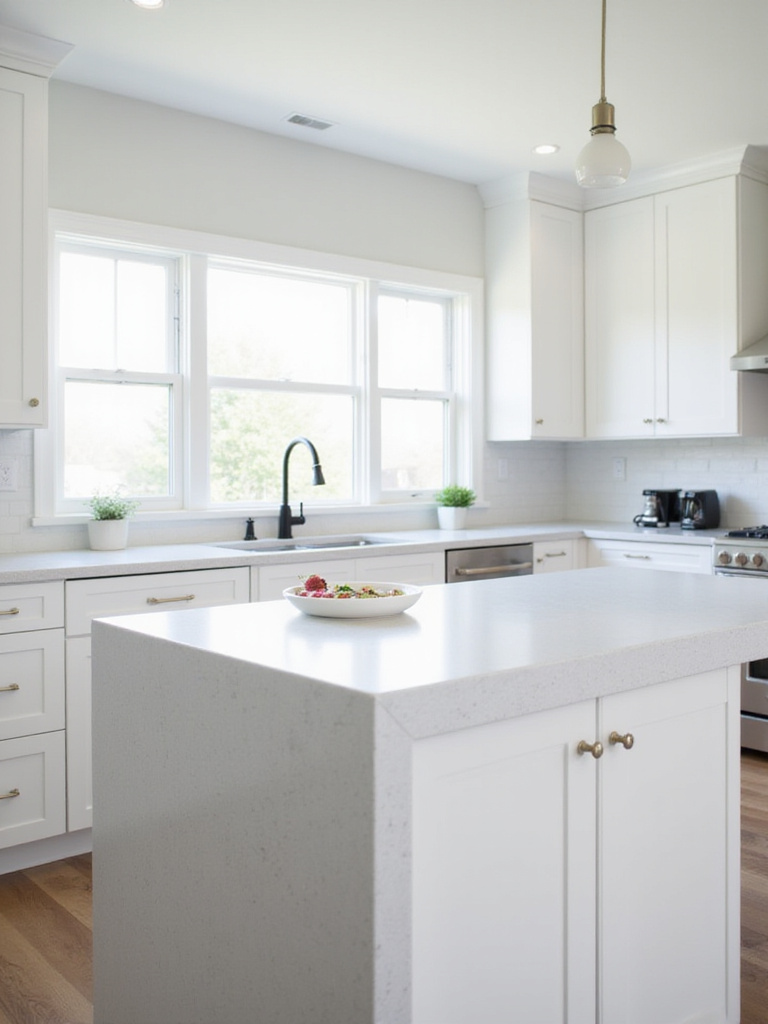
Several materials work beautifully for thick edge countertops with white cabinets. Quartz offers exceptional durability and pattern consistency, while granite provides natural beauty and unique character. Marble adds luxurious veining, though with higher maintenance needs. Butcher block brings warmth and organic texture, creating a substantial yet inviting profile. The fabrication technique—whether solid slabs or mitered edges that create the illusion of thickness—affects both cost and aesthetic, with mitered edges often providing a more economical path to achieving this substantial look.
The dramatic presence of thick edge kitchen countertops with white cabinets makes them particularly effective in open-concept spaces where the kitchen needs to make a strong visual statement. The increased edge profile creates natural visual boundaries that help define the kitchen zone within larger living areas.
18. Thin Edge Countertops: Sleek Minimalism for White Cabinet Kitchens
Thin edge countertops create an elegant, minimalist aesthetic when paired with white cabinets, emphasizing clean lines and visual lightness. This sleek profile appears to float above the cabinetry, creating an airy, contemporary feel that’s particularly effective in smaller spaces where visual weight needs to be minimized. For creative professionals designing compact live-work spaces, thin edge countertops with white cabinets maintain openness while providing necessary function.

Materials like quartz, solid surface, and certain types of granite work exceptionally well for thin edge applications, offering the necessary strength while maintaining a slim profile. When selecting materials for thin edge countertops, durability becomes particularly important, as thinner edges may be more vulnerable to chipping. The minimalist impact is maximized when paired with simple cabinet styles—slab doors or clean-lined shaker cabinets with minimal hardware create a cohesive contemporary look.
- Incorporate under-cabinet lighting to highlight the thin profile
- Consider a waterfall edge on islands to extend the sleek aesthetic
- Choose cabinet hardware that echoes the thin, minimal lines
The restrained elegance of thin edge kitchen countertops with white cabinets creates spaces that feel intentionally designed rather than merely decorated. This approach honors the modernist principle that beauty emerges from perfect function rather than applied ornamentation.
19. Waterfall Edge Countertops: Architectural Statement for White Kitchen Islands
Waterfall edge countertops transform ordinary kitchen islands into extraordinary architectural features when paired with white cabinets. This dramatic design detail, where the countertop material cascades vertically down the sides of the island to the floor, creates a seamless flow of material that instantly elevates the entire kitchen. Against the clean backdrop of white cabinetry, a waterfall edge becomes a powerful focal point that draws the eye and anchors the space with unmistakable contemporary flair.

Several materials excel when used for waterfall edges with white cabinet kitchens. Quartz offers consistent patterning that flows beautifully from horizontal to vertical surfaces, while granite brings natural character and unique veining that creates a one-of-a-kind statement. Marble provides luxurious elegance but requires more maintenance, and concrete delivers industrial chic with textural interest. The material choice significantly impacts both the aesthetic and practical considerations of your waterfall edge, from seam visibility to weight and structural requirements.
“A waterfall edge isn’t just a design detail—it’s a philosophy that treats countertops as sculptural elements rather than merely functional surfaces.”
The architectural impact of waterfall edge kitchen countertops with white cabinets makes them particularly effective in open-concept spaces where the kitchen island is visible from multiple angles. This treatment ensures the island looks finished and intentional from every viewpoint.
20. Kitchen Island Focal Point: Contrasting Countertops with White Cabinets
The kitchen island offers prime real estate for creating a stunning focal point through contrasting countertop materials when surrounded by white cabinets. This central placement naturally draws attention, making it the perfect opportunity to introduce a statement material that might be too bold or maintenance-intensive for the entire kitchen. For kitchen countertops with white cabinets, this strategic contrast creates visual hierarchy and design interest while maintaining the bright, open feel of the overall space.

Several countertop materials make particularly effective island focal points. Exotic granite varieties with bold veining patterns create dramatic natural artistry. Butcher block adds warmth and tactile appeal that softens the crispness of white. Concrete brings industrial edge and customization possibilities. Marble, while higher maintenance, offers unmatched luxury on a less-used surface. The island countertop can also be emphasized through thickness, edge profile, or integrated features like prep sinks or specialized work zones.
For creative professionals who use their kitchens for both cooking and occasional project work, a distinctive island countertop creates a dedicated zone that can transition between culinary and creative functions, defined by its unique material and visual presence.
21. Mix and Match Countertops: Creative Combinations for White Kitchens
Mixing countertop materials in a white cabinet kitchen creates visual interest while optimizing functionality for different work zones. This approach allows you to define distinct areas within the kitchen—perhaps durable quartz around the sink and cooking zones, with warm butcher block in prep areas where you’ll spend hours standing. For kitchen countertops with white cabinets, this strategic combination adds layers of texture and character while maintaining cohesive design through the consistent cabinetry.

Several countertop combinations work particularly well in white kitchens. Quartz and butcher block create a beautiful balance of durability and warmth. Granite and marble pair robustness with luxury. Concrete and wood offer industrial chic with organic softness. Quartzite and soapstone combine natural beauty with tactile appeal. These pairings allow you to incorporate materials you love while acknowledging their practical limitations by using them strategically rather than throughout the entire kitchen.
- Use different materials to define work zones visually
- Consider maintenance needs when placing materials (easier-care options near sinks)
- Create intentional contrast through color, texture, or finish
- Maintain cohesion through complementary edge profiles or thicknesses
For artists and makers designing functional creative spaces, mixing countertop materials acknowledges that different activities have different surface needs—a principle that applies equally to studios and kitchens.
22. Budget-Friendly Laminate: High-End Looks for White Cabinet Kitchens
Today’s laminate countertops offer remarkably convincing high-end looks at fraction of the cost when paired with white cabinets. Technological advances have transformed this budget-friendly option, with realistic marble patterns, concrete looks, and wood-grain finishes that capture the essence of premium materials without the price tag or maintenance concerns. For kitchen countertops with white cabinets, modern laminates provide accessible style that allows you to allocate budget to other areas of your kitchen or creative space.

To achieve the most sophisticated look with laminate, focus on selection and details. Choose patterns with subtle, realistic veining and textures rather than obviously fake patterns. Pay attention to edge profiles—beveled or ogee edges elevate the look beyond basic square edges. Consider the undertones of your white cabinets when selecting laminate, ensuring harmonious color relationships. After installation, strategic styling with quality accessories, hardware upgrades, and thoughtful lighting can further enhance the perceived quality of laminate countertops.
- Select marble-look laminates with delicate, realistic veining
- Choose matte or slightly textured finishes over high-gloss
- Upgrade your backsplash with quality tile to draw attention upward
- Invest in stylish cabinet hardware to elevate the entire look
For creative professionals designing multi-functional spaces on a budget, quality laminate countertops allow for a stylish kitchen without compromising funds needed for studio equipment or supplies—a practical solution that doesn’t sacrifice visual appeal.
The Perfect Pairing: Your Vision and Your Space
Selecting the ideal countertop to complement white cabinets is a deeply personal journey that balances aesthetics, functionality, and lifestyle. Whether you’re drawn to the seamless elegance of white quartz, the dramatic contrast of black granite, or the warm character of butcher block, the perfect kitchen countertops with white cabinets should reflect how you live, work, and create in your space.
As an artist who designs functional spaces, I encourage you to consider not just how your countertops will look, but how they’ll feel under your hands and how they’ll perform through years of both everyday use and creative projects. The most successful kitchens, like the most successful studios, balance inspiration with practicality—creating environments where both culinary and artistic magic can happen naturally.

